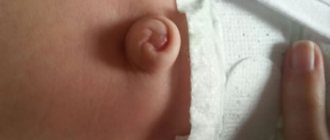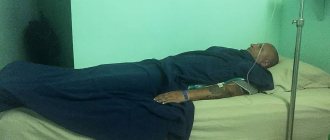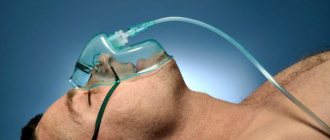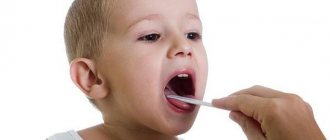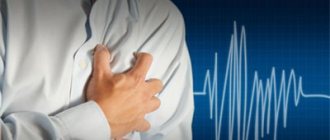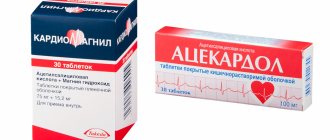What is hyperthermia?
Hyperthermia (increased temperature) is an auxiliary method used in the treatment of patients with oncological and non-oncological diseases.
In oncological practice, hyperthermia is carried out at temperatures of 41-45 ° C in order to improve the results of radiation, chemotherapy and/or hormone therapy. Its mechanism of action is to inhibit the recovery of tumor cells from damage received after radiation and drug therapy.
In non-cancer patients, hyperthermia is carried out in a moderate mode (39-40 ° C, 15-40 min). The therapeutic effect is associated with improved blood flow, tissue metabolism, increased concentration of drugs in the “sick” area and increased local immunity. In many cases, hyperthermia has a therapeutic effect in its own form, i.e. without additional use of medications.
Heating is carried out using special devices that generate electromagnetic (EM) radiation of various wavelengths.
Causes
The main causes of the disease are considered to be the following factors:
- inflammation of the respiratory tract;
- acute food poisoning;
- inflammation of the abdominal cavity;
- brain injuries, cerebral hemorrhage;
- high intracranial pressure;
- tissue necrosis;
- heart attack;
- stroke;
- purulent lesions of soft tissues;
- metabolic diseases;
- tumors;
- problems with the endocrine system;
- hereditary fever;
- heatstroke.
When is hyperthermia used?
In oncology, hyperthermia is used in cases where it is necessary to enhance the effect of radiation, chemotherapy and hormonal therapy, especially if it is known that the tumor is resistant to such types of treatment. It is most widely used in the treatment of recurrent tumors or metastases, which are usually resistant to any type of antitumor therapy.
In some cases, with contraindications to radiation or chemotherapy, hyperthermia is performed independently to improve the quality of life of patients: relieve pain symptoms and improve general well-being.
In non-oncological practice, hyperthermia is used in the treatment of chronic nonspecific inflammatory diseases (bronchitis, periodontitis, prostatitis, etc.), late radiation fibrosis.
Hyperthermia methods
The following methods of hyperthermia exist:
- External local hyperthermia - heating only the tumor.
- External regional hyperthermia is heating of an organ with a tumor and regional lymph nodes.
- Intracavitary hyperthermia is the heating of tumors of hollow organs (rectum, esophagus) using special intracavitary applicators (emitters).
- General hyperthermia - heating the entire human body, is used in extensive metastatic processes.
Contraindications to radiation therapy
- acute somatic (diseases of internal organs) and infectious diseases;
- somatic diseases in the stage of decompensation;
- severe diseases of the central nervous system and mental disorders (epilepsy, schizophrenia, etc.);
- tumor invasion of large vessels or its disintegration, threat of bleeding from the irradiated area;
- anemia, leukopenia, thrombocytopenia;
- cancer cachexia (depletion of the body);
- severe tumor intoxication syndrome.
When to see a doctor
As soon as a child begins to complain of general weakness, pain, icy or hot hands or feet, then first of all it is necessary to measure the temperature. It is immediately worth noting that if the temperature is 38.5 degrees, then there is no need to try to bring it down and worry, since the immune system itself must form active antibodies that can resist the disease. Premature babies, babies under one year old, and children with diseases of the central nervous system and heart need urgent help. In this case, you must urgently contact a clinic in the central district for highly qualified help. If hyperthermia in children is urgent, it is recommended to call an ambulance.
How is treatment carried out in oncology?
Before treatment, the necessary studies are performed (radiography, ultrasound, computed tomography, magnetic resonance imaging, etc.), with the help of which the exact location of the tumor is determined. Based on the available data, a decision is made on the method of treating the patient: the choice of device and applicator. The doctor must tell the patient about the planned treatment, the risk of side effects and measures to prevent them. The doctor chooses a treatment plan for the patient: hyperthermia technique, number of sessions and combination with other treatment methods (in agreement with other specialists). The hyperthermia procedure is carried out for 60-150 minutes and is completed immediately before radiation therapy. In the case of its combination with chemotherapy, heating is carried out during or immediately after completion of the administration of chemotherapy drugs.
External (loco-regional) hyperthermia is performed on a couch in a position comfortable for the patient. In the case of treatment of rectal cancer, an intracavitary applicator is inserted into the lumen of the tumor. The temperature in the tumor is controlled by 1-2 thermal sensors inserted into it, or it is calculated by calculation using a special program. During heating, the skin or mucous membrane is cooled by water (10-30 ° C) circulating in the applicator. Therefore, during a hyperthermia session, the patient only feels heat of varying degrees of severity and can even read or listen to music.
General hyperthermia is carried out on the Yachta-5 hyperthermic installation under general anesthesia. Temperature control is carried out in the rectum, and, if necessary, in the esophagus. During the procedure, the patient's head is cooled using cold air from a special apparatus. The course of treatment consists of 2-4 procedures, performed once every 3-6 weeks in combination with chemotherapy. Technically, general hyperthermia is carried out in the same way for all tumor locations, the difference lies in the intensity and duration of heating, as well as in the number of procedures and time intervals between sessions, which depends on the general condition of the patient.
Colds and hyperthermia
2004 will mark 50 years since scientists linked colds and flu to viruses. Today, more than 200 types of viruses and microorganisms belonging to 20 families are known that cause acute respiratory diseases (ARI), and this list is gradually growing. In children, colds are the most common infectious pathology.
Colds with improperly organized and inadequate care, including self-medication, often lead to the formation of a group of frequently ill children and the development of chronic diseases of the gastrointestinal tract and kidneys. In addition, acute respiratory infections cause the emergence of chronic foci of infection.
The penetration of pathogenic viruses and other microorganisms into the body does not always cause disease. In addition to the infectious onset, conditions are necessary that allow pathogenic microorganisms to overcome the natural nonspecific resistance of the body. One such condition is hypothermia. It is not for nothing that in English-speaking countries colds are called cold (“cold”) and their occurrence is associated with the influence of cold and wet weather. Children aged 1-5 years are most often exposed to colds due to the loss of maternal immunity and the lack of acquired immunity.
The largest number of colds is recorded in the autumn-winter-spring period, and the development of acute respiratory infections is promoted not so much by low air temperature as by its combination with high humidity. Cooling of the body occurs faster when the surface of the skin is covered with sweat, since a lot of heat is consumed when moisture evaporates. When any part of the body (and especially the feet) is cooled, the temperature of the mucous membranes of the upper respiratory tract (tonsils, nasal mucosa, etc.) reflexively decreases. As a result, the mucous membrane becomes permeable to viruses and pathogens.
Unlike adults, in children, due to the imperfection of the heat exchange mechanism, a cold can occur not only with hypothermia, but also with overheating. This is especially true for young children. It is known that 30-40% of all diseases in children of the first year of life are acute respiratory infections.
The processes of heat generation and heat transfer are closely related, they help maintain a constant body temperature, and imbalance leads to a weakening of local protection. At an early age, in untrained and unhardened children, the mechanisms of heat formation are weakened, neurovascular reactions are unstable, which, in conditions of contact with infection, leads to the development of a cold. It should be noted, however, that a child, due to the lability of nervous regulation, adapts faster than an adult to the influence of meteorological factors.
If a cold without fever in children can be considered a phenomenon that does not cause concern, then an acute respiratory infection with fever and especially with a hyperthermic reaction threatens the child with the development of serious complications. Children with perinatal encephalopathy, congenital heart defects, arrhythmias, central nervous system pathology, hereditary metabolic diseases, a history of febrile convulsions, and those born very prematurely do not tolerate fever well. Nevertheless, fever in most cases is protective in nature and its danger to the child’s body is exaggerated due to fear of possible complications.
Most viruses and pathogenic bacteria reduce their reproduction rates as the ambient temperature rises. Fever during an infectious-inflammatory disease develops due to the formation of “endogenous pyrogens” [1]. In response to infection by viruses and bacteria, circulating lymphocytes and monocytes produce cytokines, including interleukins 1 and 6, tumor necrosis factor-α. These mediators stimulate the production of prostaglandin E2 in the anterior hypothalamus, which establishes a new, higher level of temperature exchange. With fever, heat exchange disturbances of neurogenic origin mainly occur. Metabolic processes accelerate, fluid loss increases, the production of interferon and antibodies is stimulated, and phagocytosis increases.
With most colds, the maximum body temperature is set within 37-39°C, which does not threaten serious health problems. Therefore, initially healthy children with good reactivity and an adequate response to the inflammatory process in accordance with WHO criteria and domestic pediatric practice are not recommended to administer antipyretics at body temperatures below 38.5-39.5°C [3, 6].
In turn, exceeding a certain threshold becomes dangerous for the child. The limit is considered to be a body temperature above 38-39.5°C. Thus, we can assume that from this moment the risk of developing hyperthermic syndrome in the child is very high. The method of measuring body temperature should also be taken into account: axillary, rectal, tympanic, etc.
In hyperthermic syndrome, which is recognized as an absolute pathological variant of fever, there is a rapid and inadequate increase in body temperature, accompanied by microcirculation disorders, metabolic disorders and progressively increasing dysfunction of vital organs. The basis of the disorders is the pathological integration of primary and secondary altered formations of the central nervous system or the pathological system according to G. N. Kryzhanovsky [9], the activity of which has a biologically negative significance for the body. Hyperthermic syndrome requires mandatory drug correction, and physical cooling methods should not be neglected.
In the process of clinical monitoring of a child, it is important to distinguish between “red” and “white” hyperthermia. More often, prognostically more favorable “red” hyperthermia is observed, in which heat production corresponds to heat transfer. In this case, the child’s behavior is normal, the skin is moderately hyperemic, hot, moist, the limbs are warm, the increase in pulse and breathing corresponds to an increase in body temperature (for every degree above 37 ° C, shortness of breath increases by 4 breaths per minute, and tachycardia by 20 beats in a minute). “White” hyperthermia is characterized by disturbances in the child’s behavior - indifference, lethargy or, conversely, agitation, delirium and convulsions. The skin is pale, with a “marble pattern,” cyanosis of the nail beds and lips, a positive “white spot” symptom, cold extremities, excessive shortness of breath and tachycardia.
For red hyperthermia, the emergency treatment plan is to use physical cooling techniques, give the child plenty of fluids, and give ibuprofen (Nurofen for children) or paracetamol. Usually, after 3-4 hours, re-taking the drugs is required, since antipyretics have an exclusively symptomatic effect.
With “white” hyperthermia, one cannot initially count on the effect of antipyretics alone. Vasodilators are additionally administered parenterally: 2% papaverine solution, 1% dibazole solution, 0.25% droperidol solution. According to indications, nicotinic acid 5-30 mg per day and antihistamines are added.
The body temperature of a sick child is monitored every 30 minutes. Therapeutic measures aimed at combating hyperthermia are stopped after the body temperature drops to 37.5 ° C, since it can further decrease without additional interventions.
In the pathogenesis of colds, in addition to fever, inflammation and pain in the pharynx and nasopharynx are important. In the first hours and days of illness, it is difficult to make a final diagnosis, and a child, especially a young one, needs immediate help. In this regard, it is clear how important it is to have in your arsenal an effective drug that has a complex effect and does not cause side effects. Therefore, when choosing a drug to relieve fever, it is better to give preference to drugs that have antipyretic and at the same time anti-inflammatory and analgesic effects. These requirements for the treatment of colds complicated by fever in children are met by ibuprofen (Nurofen for children), the principle of action of which is based on the inhibition of cyclooxygenase activity.
Ibuprofen is a non-steroidal anti-inflammatory drug (NSAID). Possessing both antipyretic, analgesic and anti-inflammatory effects, NSAIDs do not have hormonal activity, but due to the inhibition of prostaglandin synthesis both in the central nervous system and in the periphery, they have the necessary complex effect.
Paracetamol, unlike ibuprofen, has an exclusively antipyretic effect. It is currently recommended to limit the use of acetylsalicylic acid and metamizole in children, given the risk of severe complications. Pyrazolone and para-aminophenol derivatives, which have been used in pediatrics for a long time, are prohibited for use in children due to significant side effects [7, 10].
Data on the frequency of use of antipyretic drugs in Russia are contradictory. Nevertheless, paracetamol for the treatment of colds accompanied by fever is prescribed by more than 90% of pediatricians, ibuprofen by more than 50%, and acetylsalicylic acid by about 30% [2, 5]. Abroad, since the late 80s, ibuprofen has been actively used in pediatric practice as an antipyretic drug, an alternative to paracetamol, which is sold in pharmacies without a prescription.
We studied the effectiveness, safety and tolerability of a pediatric ibuprofen suspension (Nurofen for children). The range of indications for prescribing the drug includes infectious-inflammatory and post-vaccination fevers, pain due to otitis media, teething and dental diseases, headaches, sprains and other types of pain.
70 children aged 6 months to 12 years (mean age 5.3+1.6 years, 29 girls and 41 boys) had cold symptoms and hyperthermic body temperature. Approximately half of the children had complications in the form of otitis media, sinusitis and obstructive bronchitis. All children received Nurofen for Children as an outpatient.
Criteria for inclusion in the study: fever above 39.0°C in children with a favorable premorbid background and above 38.0°C in children at risk (history of febrile seizures, neurological pathology, congenital heart disease), informed written consent of parents. Sick children who simultaneously received paracetamol, as well as patients who had hypersensitivity to Nurofen, were excluded from the study.
Nurofen for children was prescribed in accordance with generally accepted recommendations in a single dose of 10 mg/kg 3-4 times a day in the presence of fever and pain (headache, earache, sore throat, arthralgia) for 3-7 days.
Information about the child’s well-being was recorded daily, and body temperature was measured repeatedly while taking the drug. The effectiveness of treatment for children was assessed in accordance with the study protocol based on the dynamics of clinical symptoms of the disease. A scoring scale was used to characterize individual clinical symptoms. Tolerability of Nurofen for children was characterized by the presence or absence of side effects during treatment.
In almost all children with colds, a single dose of Nurofen for children led to a decrease in body temperature by 1-1.5 ° C and the disappearance of pain in the pharynx. In sick children at risk, when the drug was prescribed at a body temperature of less than 39.0°C, the antipyretic effect of Nurofen for children developed 30 minutes after its administration. Over the course of 1.5 hours, an approximately uniform decrease in body temperature was recorded, amounting to a total of 3.9% of the initial elevated body temperature. It was noted that within 90 minutes in all children in this group after using Nurofen for children, body temperature decreased to 37.0-37.2°C.
When the initial body temperature in children was above 39.0°C, after taking Nurofen, a more intense, but not as uniform, decrease in fever was observed. Thus, 30 minutes after taking the drug, a decrease in body temperature by 1-1.5°C was noted in 58.3% of children, after 60 minutes - in 86.1%, after 90 minutes - in 94.4%. After 120-150 minutes of observation, the overall rate of drop in body temperature in 36 children with a favorable premorbid background was 4.4% of the initial value. It should be noted that for children with the “white” type of fever (3 children), Nurofen for children was prescribed in combination with papaverine in a single dose of 5-10 mg, depending on age.
The positive side of using Nurofen for children is the fairly persistent antipyretic effect observed in children. In most cases, after relief of hyperthermia, low-grade fever, or body temperature within the range of 37-37.8°C, remained for 2-3 hours (see figure). A repeated rise in body temperature was the basis for further use of the drug. We did not practice regular, strictly timed, administration of Nurofen for children, as is customary during a course of treatment.
| Drawing. Dynamics of body temperature in children with fever while taking Nurofen |
In addition to the antipyretic, Nurofen also has an analgesic effect for children, which was recorded when the drug was prescribed to children with symptoms of intoxication (headache, etc.), as well as with acute catarrhal otitis media. Using a pain rating scale, we found that positive changes were noted within 30 minutes after taking the drug suspension. The analgesic effect of Nurofen for children is also very long-lasting and usually lasts at least 2.5 hours.
Our comparative study, as well as data from other authors, showed that ibuprofen at a dose of 10 mg/kg and paracetamol at a dose of 15 mg/kg give a similar analgesic result - headaches, sore throats and arthralgia disappear. In both groups, the effect was significantly more pronounced than with placebo [6]. Thus, all 6 children with otitis who received Nurofen for children showed positive dynamics on a valid rating scale.
The average period of “course” use of Nurofen for children was 4.1 + 1.4 days. As clinical symptoms improved, the number of drug doses decreased, and the absence of fever and pain served as indications for its discontinuation.
Nurofen for children in the form of a suspension is well tolerated, the drug is safe and has a pleasant taste. It should be noted that with short-term use of ibuprofen, the risk of developing undesirable effects is quite low [10].
Thus, the observations showed a high antipyretic effect, good tolerability and safety of the Nurofen suspension for children in the treatment of patients with colds against the background of hyperthermic and pain syndromes. Nurofen for children can be used in pediatric practice as an over-the-counter form.
The persistent and long-lasting effect of Nurofen for children allows us to recognize it as a highly effective treatment for colds accompanied by hyperthermic syndrome. In recent years, ibuprofen has been recommended for children as one of the main antipyretic drugs. It should also be noted that antipyretics should be prescribed to children only if the fever exceeds the permissible limit and leads to dysfunction of the cardiovascular, central nervous and other systems [5, 7].
Literature
- Ado A.D. The doctrine of fever // Klin. honey. 1994. No. 1. P. 67-70.
- Baranov A. A., Geppe N. A. Optimization of antipyretic therapy in young children with respiratory viral infections // Ros. pediatric magazine 1999. No. 5. P. 52-54.
- Vetrov V.P., Dlin V.V., Osmanov I.M. et al. Rational use of antipyretics in children. M.: Moscow Research Institute of Pediatrics and Pediatric Surgery. 2000. 22 p.
- Geppe N.A. On the issue of the use of antipyretics in children // Klin. Pharmacol. and ter. 2000. T. 9. No. 5. P.51-53.
- Zaprudnov A.M., Grigoriev K.I., Mazankova L.N., Kharitonova L.A. Efficacy and safety of the drug Nurofen for children // Children's Doctor. 2001. No. 2. P. 23-25.
- Zaprudnov A. M., Kharitonova L. A., Grigoriev K. I., Mazankova L. N. Modern tactics for relieving fever in children / Pharmacotherapy of infectious diseases in children // Consilium medicum. 2001 (Appendix). P.21-24.
- Korovina N. A., Zaplatnikov A. L., Zakharova I. N. Fever in children. M., 2000. 66 p.
- Korovina N. A., Zaplatnikov A. L., Zakharova I. N., Ovsyannikova E. M. Antipyretic drugs in the practice of a pediatrician // Ros. Vest. perinatol and pediatrician. 2001. No. 3. P. 50-54.
- Kryzhanovsky G.N. Pathological systems in the activity of the central nervous system // Vest. Ross. Academician honey. Sci. 2002. No. 6. P. 18-23.
- Tatochenko V.K. On the safe use of antipyretics in children // Children's Doctor. 1999. No. 2. P. 36-37.
- Vertin L., Pons G., d'Athis P. et al. A randomized, double-blind, multicentre controlled trial of ibuprofen versus acetaminophen and placebo for symptoms of acute otitis media in children // Fundam. Clin. Pharmacol. 1996. Vol. 10. P. 387-392.
How are non-cancer patients treated?
When treating non-cancer patients, compared to oncology patients, a lower temperature regime (39-40 ° C) and a shorter exposure (15-40 min) are used. On the other hand, this treatment is similar to physical therapy, which also uses EM radiation. The difference is that during physiotherapy the level of heating in the inflammatory area is very weak, not exceeding 37.5-38 ° C (mostly the skin is heated). Therefore, the therapeutic effect of physiotherapy is associated with the specific effect of the EM field and least of all with the thermal effect. In hyperthermia, the therapeutic effect is mainly associated with the effect of heat.
What is the danger
Hyperthermia syndrome is dangerous for a child’s health, since it can seriously inhibit its development, affect the functioning of the heart, lungs, blood vessels, and other organs, which is why a negative response is quite possible. The pathology may well develop and cause constant weakness and pain. As a result, the temperature will completely knock the child off his feet and he will need serious, highly qualified help. If the baby is not helped in time, he will end up in the hospital for at least several months in order to normalize the body’s functioning and restore the temperature. In the worst case, death is possible. That is why it is important to choose the best specialists and a reliable clinic for treatment.
Side effects of hyperthermia
Side effects are observed when treating only cancer patients due to the need to maintain a high temperature in the tumor (41-45 ° C) and the duration of exposure.
As a rule, after the procedure, the skin at the site of heating turns red and acquires a normal color within 4-6 hours. But in some cases, pain and swelling of the skin and underlying tissues may appear, and rarely, skin burns, which are observed mainly in patients with lost tactile and thermal sensitivity after previous radiation therapy or surgery. All of the above changes are amenable to conservative therapy. If the skin is red, you can use creams and lotions to care for baby skin. In case of burns - Panthenol aerosol. The skin after hyperthermia requires careful and gentle treatment, so patients should wear loose clothing that does not restrict the place where the heating is carried out and does not rub the skin. Underwear should be made of linen or cotton fabric. To carry out hygiene procedures, you should use warm water and gentle (baby) soap.
At the Federal State Budgetary Institution “National Medical Research Center of Radiology” of the Ministry of Health of Russia, each case of the disease is considered at an interdisciplinary council with the participation of an oncologist, surgeon, oncomorphologist, oncologist-radiologist and many other specialists who work together to jointly determine the patient’s treatment tactics.
Tel.
Call center +7 495 – 150 – 11 – 22
Call us today so we can help you!
